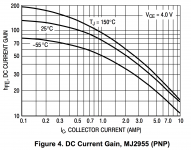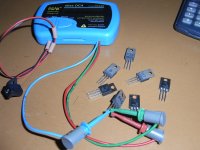I have revived an old Maplin disco amp.
Had some trouble with it oscillating.
I checked the new transistors I fitted and the MJ2955 has an HFe of 273 !
My datasheet says it should be 20-70.
No wonder my amp oscillated.
I added a slightly larger cap to VAS and that tamed it.
I got the MJ2955 from Farnell so it should be a genuine part.
I thought at first it might be my semiconductor analyser playing up but my 2N3055 has an HFe of 65 which is in spec.
Had some trouble with it oscillating.
I checked the new transistors I fitted and the MJ2955 has an HFe of 273 !
My datasheet says it should be 20-70.
No wonder my amp oscillated.
I added a slightly larger cap to VAS and that tamed it.
I got the MJ2955 from Farnell so it should be a genuine part.
I thought at first it might be my semiconductor analyser playing up but my 2N3055 has an HFe of 65 which is in spec.
Last edited:
Depends also at which Ic the tester is measuring.
For low Ic, and Tj > 25C, Hfe can get over the 150 area. Though 200+ seems a bit high.
Its just a battery powered tester so puts out 2.5mA.
The tester is amazing, it works out which pin is which so you dont have get the data book out for connections.
Depends also at which Ic the tester is measuring.
For low Ic, and Tj > 25C, Hfe can get over the 150 area. Though 200+ seems a bit high.
Thanks for the graph, my datasheet is a bit basic.
Apparently Farnell is selling re-branded parts under the names Multicomp and Solid State.
No telling what you're actually getting.
I usually buy from RS but they didn't have any.
RS is usually better than Farnell for quality.
I would have thought Farnell is still better than ebay.
Farnell have thousands in stock so there are still plenty around.
If it is one of the clones of the AVR based tester, I have one tooIts just a battery powered tester so puts out 2.5mA.
The tester is amazing, it works out which pin is which so you dont have get the data book out for connections.
AVR Transistortester – Mikrocontroller.net
If it is one of the clones of the AVR based tester, I have one too
AVR Transistortester – Mikrocontroller.net
Mine is an Atlas Peak semiconductor analyser.
I use this one most as it is so easy to use.
I have another one which does a lot more but you have to connect the right wire to the right pin before it works. I bought it to test for breakdown voltage of transistors.
Oops. accidentally deleted my post trying to edit.
I try to stick to major manufacturers such as ST or OnSemi, usually buy from Mouser or Digikey although I'm in the US so they may not be as easy for you to deal with.
Weird getting a power transistor showing that high of an Hfe though, only way to be sure is to test it at the specified currents. But if it was oscillating like that something must be off.
I try to stick to major manufacturers such as ST or OnSemi, usually buy from Mouser or Digikey although I'm in the US so they may not be as easy for you to deal with.
Weird getting a power transistor showing that high of an Hfe though, only way to be sure is to test it at the specified currents. But if it was oscillating like that something must be off.
Mine looks like this. I bought it quite some time ago for less than $10 shipped IIRC.
Pretty nice device. Measures pretty much everything (R, C, L, BJT, D, Z, FET), with a decent amount of precision, and for BJT, you just plug them in and recognizes BCE layout.
Works partially with FETs as well, but it can be tricked by the body diode in case they have.
Overall, probably the best value per buck I have spent in instrumentation

YouTube
Pretty nice device. Measures pretty much everything (R, C, L, BJT, D, Z, FET), with a decent amount of precision, and for BJT, you just plug them in and recognizes BCE layout.
Works partially with FETs as well, but it can be tricked by the body diode in case they have.
Overall, probably the best value per buck I have spent in instrumentation

YouTube
It was a lot cheaper than mine.
I think it was about £50.
I think it was about £50.
An externally hosted image should be here but it was not working when we last tested it.
I've never seen the Peak Atlas advertising or user guides show anything bigger than a TO220 mosfet being properly gain-tested on either of their semiconductor testers. I think there is a similar limitation for any little tester that can only supply a few mA test current. My DCA75 also shows garbage for Hfe with many 10-15A, low gain power transistors - not all but too many to be ignored. To be serious, you need a collector current of 0.5A at around 10V supply to test Hfe and that's only at the low end of MJ2955 spec. range. This isn't difficult with almost any metered bench power supply, a few watts of power resistor to bias it and a heatsink of about 2°/Watt- no thermal pad required for a quick test. Otherwise, you only have an indication that there is a current increase due to to some effect, possibly mixed with leakage current.
ST Microelectronics - datasheet pdf
Imagine how easy life would be if you really could check power transistor parameters with just a few mA.
ST Microelectronics - datasheet pdf
Imagine how easy life would be if you really could check power transistor parameters with just a few mA.
Last edited:
What ever happened to the O-Scope adapters with an X-Y output that displays a complete plot over a scope full of ranges ?
Oh I found one on Ebay, about 30 USD assembled with schematic. I would want to add a blanking mod.
BJT Transistor Curve Tracer adapter PCB board X-Y Oscilloscopes Assembled Kit | eBay
Oh I found one on Ebay, about 30 USD assembled with schematic. I would want to add a blanking mod.
BJT Transistor Curve Tracer adapter PCB board X-Y Oscilloscopes Assembled Kit | eBay
Last edited:
Looks like a great little project, just for the educational value. It seems from the specs that test base current might be limited to the same few mA which still wouldn't be much use for power transistors.....Oh I found one on Ebay, about 30 USD assembled with schematic. I would want to add a blanking mod......
- Capable to check IV curve both NPN / PNP Power Transistor / Small Transistor
- 8 step Ib 0uA,24uA,48uA,72uA,96uA,120uA,144uA,168uA for small transistor
- 8 step Ib 0.0mA,0.32mA,0.64mA,0.96mA,1.28mA,1.6mA,1.92mA,2.24mA,
- Vce = +10V for NPN and -10V for PNP
- Switching frequency 642Hz
- 2 Jumper to select ranges of Ib and type of transistor { NPN / PNP }
- Require 2 CH Analog or Digital Oscilloscope in x-y mode to connect both CH to this adapter board ( CH1 is X-Axis and CH2 is Y-Axis )
- Comes with the schematic diagram
- Comes with 2 x free BNC BULKHEAD JACK
- PCB size 9.0cm x 10.0cm
Otherwise, you only have an indication that there is a current increase due to to some effect, possibly mixed with leakage current.
It got me out of a hole with a faulty amplifier.
All transistors checked out ok on the multi-meter.
When I put them on the Atlas it showed one of them had an HFE of 1 !
I also use the Peak Atlas DCA55 tester and find it is rarely wrong. I use it so often that I fitted a 12V DC supply from a wall wart to replace the expensive battery that never seems to last very long and also should remove any battery voltage-related uncertainty. Here it is doing its job on a batch of eBay TIP41C transistors supposedly manufactured by ON Semiconductors that gave Hfe gain readings between 8 - 936! Needless to say, they didn't go anywhere near the amplifier I was repairing.
Attachments
BJTs have rarely been ideal. They have low current gain at low currents due to recombination and low current gain at high currents to to high level injection effects. They have a sweet spot somewhere between these limits. Early power transistors like the RCA-2N3055 often had a gain of 150+ at around 100mA, but as they were used for power apps the data sheet spec. gave the gain at 4A, when it was on its down curve.
Using a couple of mA for a power transistor could be anywhere in its low current to mid-current gain range. The latest ring emitter devices have a much better (flat) gain characteristic from low to high currents and are closer to the ideal BJT than older devices.
Using a couple of mA for a power transistor could be anywhere in its low current to mid-current gain range. The latest ring emitter devices have a much better (flat) gain characteristic from low to high currents and are closer to the ideal BJT than older devices.
- Status
- This old topic is closed. If you want to reopen this topic, contact a moderator using the "Report Post" button.
- Home
- Amplifiers
- Solid State
- HFe 273 ? you must be joking.

